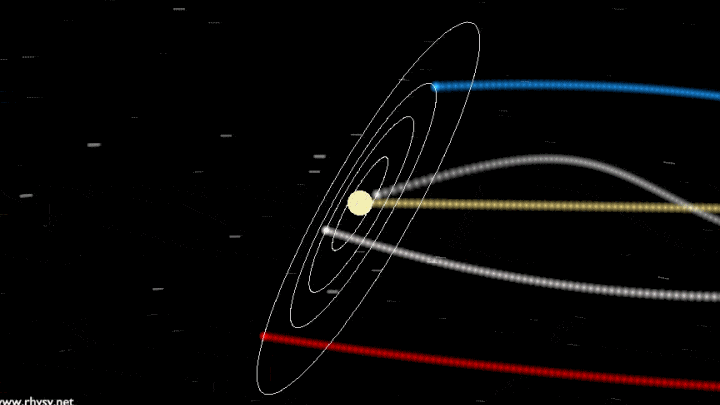July 24, 2023 / Instructions / Space speeds: how fast do you need to travel to depart from Earth, the solar system, and the galaxy?
Despite the challenging state of domestic space exploration, there is a growing interest in space among people of all ages and educational backgrounds. Thanks to the efforts of private investors and science popularizers, the mysteries of outer space are becoming more intriguing, attainable, and comprehensible, attracting inquisitive individuals who seek to acquire new knowledge.
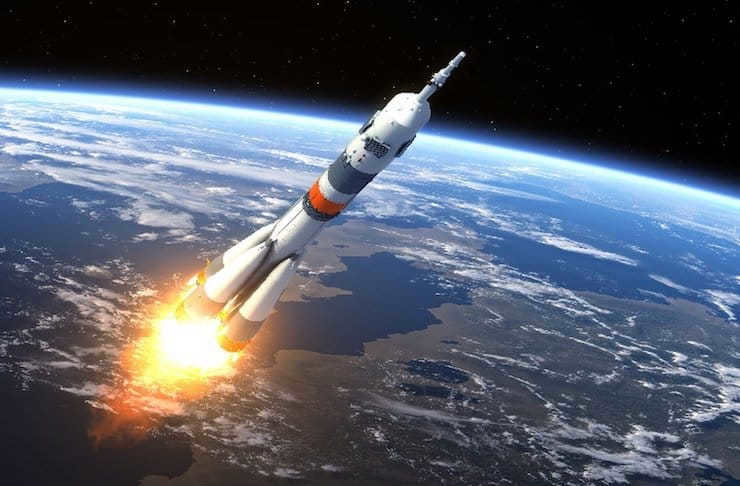
This article will provide a concise overview of space velocities required to overcome the gravitational forces of celestial bodies. While news reports frequently mention terms like “first, second, third, fourth space velocity,” not everyone comprehends the specific speeds involved or how they are calculated.
What is the definition of space velocity?
In the field of cosmonautics (which encompasses all launches of artificial spacecraft), space velocities are used to determine the minimum speed necessary for various objectives:
1. Orbiting the Earth;
2. Escaping the Earth’s gravitational field;
3. Traveling beyond the solar system;
4. Venturing beyond the Milky Way galaxy.
These formulas for calculating space velocities can be applied to any celestial body in the Universe, but we will focus on the values relevant to spacecraft orbiting Earth.
The initial speed required to orbit the Earth is 7.9 km/sec.
In order for a satellite to stay in orbit around the Earth, it must reach a certain initial speed, also known as the circular velocity. For our planet, this speed is approximately 7.9 km/sec. When the satellite reaches this speed, it experiences a centrifugal force that counteracts the Earth’s gravitational force, allowing it to stay in orbit.
Now, let’s consider an interesting scenario. What would happen if we manipulate the numbers in the formula used to calculate the initial cosmic velocity (V1 = (GM/R)^1/2, where M is the mass of the object, R is the radius, and G is the gravitational constant) and replace the values with those that correspond to the speed of light (slightly less than 300,000 km/sec)?
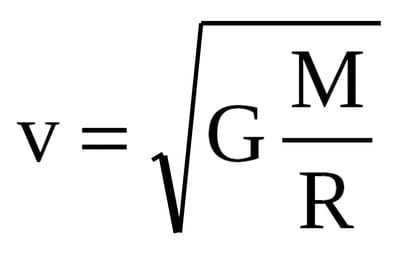
An astronomical phenomenon that is widely known and referred to as a “black hole” is an object with a massive mass and a small radius. It is capable of capturing light within its gravitational field, making it impossible for photons to escape. This is due to the requirement of surpassing the speed of light, which is currently deemed impossible in the known Universe.
Back in 1959, the Soviet Union successfully sent out Luna-1, an unmanned spacecraft that marked a major milestone in space exploration. It was the first man-made object to break free from Earth’s gravitational pull and become a satellite of the Sun. To achieve this feat, the spacecraft had to reach the second cosmic speed, also known as escape velocity, which is approximately 11.2 km/sec for our planet. Once it reached this speed, Luna-1 entered a parabolic orbit, theoretically capable of taking it infinitely far from Earth, assuming no other celestial bodies interfere with its trajectory.
The third space velocity is 16.6 km/sec.
Calculating the precise value of the third space velocity is a challenging task due to its variability. The angle at which the spacecraft is launched in relation to Earth’s orbital path and its interaction with the gravitational forces of other celestial bodies greatly influence its speed. These factors can either accelerate or decelerate the spacecraft, resulting in a wide range of possible velocities. However, the minimum estimated value for the third space velocity is 16.6 km/sec.
The velocity of the fourth dimension in space – 400-600 km/sec.
The term is seldom used because the values associated with it are currently unattainable in our space exploration endeavors. The concept of the fourth space velocity refers to the spacecraft’s departure from the Milky Way galaxy, which is currently deemed impossible given our current technological capabilities and foreseeable advancements. Considering that our solar system revolves around the galactic center at approximately 220 km/sec, the estimated speed required for an artificial vehicle to venture beyond the Milky Way ranges from 400-600 km/sec.
🔥 See also:
How helpful is this article?
Click on a star to rate it!
Average rating 5 / 5. Number of ratings: 312
No ratings yet. Be the first one to rate.
Author does not deceive, and there is no nonsense that drives the solar system. No apparatus has yet left, despite what many may think. However, the reality is not quite as straightforward, unfortunately. So, it is important not to lie if you do not understand something. As for the existence of black holes, there are hypotheses, but recently they have been floating around without any solid evidence. It’s like a discrepancy between debit and credit. Please log in to reply.
There are many claims, but they do not hold much sense. If you search for information on the limits of the sun, you will find that it extends for about two light years. So, it’s up to you to form your own opinion. Please log in to reply.
The definition of the solar wind sphere was so groundbreaking that it earned the Nobel Prize, showing just how little they knew before. Sign in to leave a comment.
All of this is not just from yesterday, but from a century ago. However, with the advent of new technologies, it is necessary to take a different approach to space logistics and communication.
In this regard, it is crucial to completely revamp the design and composition of multi-stage rockets. What is needed is an airborne launch platform (ALP) equipped with a nuclear propulsion system (NPS). This ALP could take the form of a torus-shaped drone with multiple thrusters, capable of lifting an orbital module-rocket (OMR) to an altitude of 60-100 km. The OMR would be housed within the torus and launched from this height without the need for any additional stages. Alternatively, the ALP could be designed as a torus airship utilizing hot air saturation generated by the NPS. Upon completion of its mission, the ALP would rendezvous with the MPA and return to the ground. The ALP would be reusable, resulting in significant cost savings compared to disposable stages. Additionally, the ALP could double as an air combat system, capable of patrolling near our “partners'” borders. Sign in to leave a comment.
)))))))))))) Nuclear installation. Do you know where to go with your proposals? Well, at least go beyond the Moon and launch there. You’re an astronaut, a scout, a test pilot. ))))))))))))) To come up with such nonsense ))))))))))) How many takeoffs from Earth will be enough? 3-4 and we’ll be on Mars. Log in to reply
You can leave at any speed if the engine is constantly running. These are all free flight speeds when the engines are off.
And this is what a colonel wrote: “In 2013, Voyager 1, having traveled more than 18 billion kilometers and reached a speed of about 17 km/sec.”
Not gaining 17 kilometers per second, but losing up to 17 kilometers per second. Because in 1990, Voyager was traveling at over 25 km/sec, but it is gradually slowing down due to the Sun’s gravity. Log in to reply
Is it possible that the Voyagers will remain in place and the sun’s gravity will eventually bring them back, causing their escape velocity to decrease to zero? Login to provide an answer.
Light is unable to fall, as a photon possesses no mass and cannot exit a supermassive object as a result of the spatial distortion. Please log in to respond.
))))))))) It’s hilarious to the point of tears. Everyone is aware that the gravitational force of the Earth is equivalent to 9.8, so what’s the big deal? Let’s just make it 9.9 and have the freedom to travel anywhere. If we consider the scenario of flying beyond the Earth’s atmosphere, then we would need to accelerate in space. It’s even possible to travel at a leisurely speed of 5 km per hour there.)))))))))) Now let’s calculate how long it would take to exit the solar system at this speed. However, to be completely honest, the speed of light is only sufficient for interstellar voyages, not intergalactic ones. Well, at least it’s 10 times faster and enough to traverse our galaxy. And that’s ALL. For intergalactic journeys, we would need to exceed the speed of light at least 19 times. And under these circumstances, we would have to fly for months or even years. Log in to reply
The force of Earth’s gravity is not 9.8 m/s^2, but rather the acceleration of free fall. What is 9.9? Is it an acceleration? Speed and acceleration are distinct measurements. Furthermore, in space, the laws of universal gravity govern. If you are traveling at a speed of 5 kilometers per hour, the laws of physics will bring you back to the ground. The outcome depends on your location in space; Lagrange points exist for a purpose. Physics remains physics… Login to respond

If the sun is in front of us and we are attempting to surpass it, then we are heading towards the sunset, which is located in the west.
On the other hand, if the sun is situated in the east, there is no need for any movement: the sun will naturally move behind us, and all we have to do is wait for the evening. Similarly, if the sun is positioned in the south (or in the north for individuals in the southern hemisphere), it will traverse horizontally. Of course, it will eventually be at our back, even if we are simply standing. However, firstly, it will be nighttime when the sun is not visible, and secondly, it would be difficult to claim that we have overtaken it.
Chasing the sun.
As the sun sets in the west, our mission is to chase after it in the same direction. The question is, how fast should we be running in order to prevent it from setting and instead make it rise higher and higher until it eventually appears in the East?
To clarify, our goal is not to overtake the Sun itself, but rather the Earth. This is because the Earth’s rotation on its axis is what causes the transition between day and night, and consequently, the movement of the sun across the sky. In order for the sun to remain stationary, we would need to match the speed at which the Earth rotates. However, if we wish to surpass the sun’s current position, we must move at a slightly faster pace.
What is the velocity with which the Earth rotates? There is no definitive answer expressed in kilometers per hour or in meters per second. The Earth completes one rotation per day, which is equivalent to 24 hours. Therefore, each location on its surface “travels” the length of its latitude in 24 hours. Imagine spinning a globe. Locations on the equator (the longest latitude) will move at a much higher speed compared to locations at the pole, where the latitude is much shorter. Meanwhile, the poles themselves will simply remain stationary.
What is the optimal speed for running?
The optimal speed for running depends on various factors, including your geographical location and proximity to the equator. Regardless, it is important to maintain a consistent pace.
If we consider the length of the equator, which is approximately 40,000 kilometers, we can calculate the speed required to “catch up” to the sun. Each point on the equator covers a distance of 40,000 kilometers in a day, which means it would cover around 1,700 kilometers in an hour. To surpass the sun’s position at the equator, one would need to travel at a speed of 1,700 kilometers per hour. This is nearly one and a half times the speed of sound in air, which is approximately 332 m/s or around 1,200 kilometers per hour. Therefore, to overtake the sun, one would need to travel in a supersonic airplane or at a similar velocity.
The length of the parallel decreases and it becomes easier to outpace the sun as one gets closer to the pole. In close proximity to the pole, it is possible to elude the sun by walking in a circular path at a certain distance from the Earth’s imaginary axis. However, at the North Pole, regardless of the direction one looks, it is always towards the south, rendering the concept of sunrise and sunset irrelevant.
Race against Time: an Interactive Workshop
The time difference between Yakutsk and Moscow is 6 hours, resulting in the sunrise and sunset occurring in Moscow approximately 6 hours later than in Yakutsk. A flight from Yakutsk to Moscow has a duration of 6 and a half hours. This interestingly means that the aircraft nearly catches up with the sun, resulting in a flight that departs Yakutsk at dawn also arriving in Moscow at dawn.
Now, when it comes to spaceships, their speed surpasses that of passenger airplanes by a significant margin, making it quite effortless for them to surpass the sun. Astronauts on board spaceships overtake the sun multiple times throughout the day. As an example, the International Space Station completes one orbit around the Earth in a mere 90 minutes – a remarkable 16 times faster than the sun.
Incidentally, under these circumstances, the concept of counting days and nights is completely altered for astronauts. Day and night shift for them a staggering 16 times within a 24-hour period. Astronauts adhere to what is known as Greenwich Mean Time, which is based on the time at the Prime Meridian.
dvaman 29.07.2006 18:16 Reply
00000 18.04.2008 03:04 am Reply
Fiktor 29.01.2009 01:21 am Reply
I apologize, but the statement “The International Space Station completes one orbit around the Earth in just 90 minutes – 16 times faster than the sun” actually refers to the transition from day to night occurring 15 times a day, not 16.
“By the way, in these conditions the concept of counting days and nights in the traditional sense is completely lost for the inhabitants of the Earth – as day and night shift for astronauts 16 times in a 24-hour period.”
Fiktor 01.01.2010 19:32 Reply
> Spaceships can travel much faster than passenger airplanes, allowing them to easily overtake the sun. However, while the first statement is true, the second one is not accurate. It was previously agreed that overtaking the sun would only be considered if the spacecraft was traveling westward. Sadly, the majority of spacecraft tend to go in the opposite direction, towards the east. To be honest, I am unsure if any humans have ever successfully orbited westward.
By the way, do you happen to know where I can find this information?
Yuri-2010 12.02.2011 09:48 am Reply
The perception of radial movements of objects depends on the observer’s location, whether they are on Earth or in orbit around it. In this case, only the component of Earth and Sun’s movements along the observer’s line of sight is taken into consideration.
These motions are more noticeable when observed from a lateral perspective. In cases where physical distance cannot be increased, these movements can be calculated theoretically.
The Sun is located approximately 26,000 light years away from the center of the Milky Way galaxy. It orbits around the galaxy, completing one revolution in over 200 million years. As a result, the Sun’s orbital velocity is estimated to be around 217-220 km/s.
On the other hand, the Earth follows an elliptical orbit around the Sun at a distance of about 150 million kilometers. Its average speed is approximately 29.765 km/sec. However, this speed varies depending on its position in the orbit, ranging from 30.27 km/sec at perihelion to 29.27 km/sec at apogee.
This model provides a better explanation of the concept of “overtaking the Sun”, but it does not take into account other factors. However, for those who wish to include them in their calculations, the following can be considered:
- The solar system, which includes the Sun, is moving at a speed of approximately 20 km/s towards a point known as the apex. This point is located at the boundary between the constellations Lyra and Hercules.
- There is also a motion of the Solar System relative to the plane of the Milky Way galaxy. Currently, the displacement to the North Pole of the Galaxy is only 10 parsecs.
- Additionally, both the Solar System and the Milky Way galaxy are experiencing acceleration as the Universe expands.
- Furthermore, the Earth follows a spiral path in space, which is influenced by the motion of the Sun.
Therefore, it is simple to determine the specific locations in space where the Earth surpasses the Sun in the galactic orbit, as well as where it falls behind in relation to the Sun. Only a few locations exist where they, the Earth and the Sun, travel at the same velocity (only at points directly ahead or directly behind the Sun).
What say you, esteemed moderators?
Will you retain any portion of the original text in the comments?
taras Yuri-2010 08.06.2017 12:29 pm Reply
“In reality, the Earth overtakes the Sun along the galactic orbit for nearly six months and “allows itself to be overtaken” for an equal amount of time by moving along its orbit in the opposite direction to the Sun’s motion along the galactic orbit.” No. This is not possible because the Sun’s orbit and the Earth’s orbit are situated on different planes.
arina.krasilnickowa 07.09.2011 19:28 Reply
taras arina.krasilnickowa 08.06.2017 12:27 pm Reply
iliaefr26 arina.krasilnickowa 29.04.2020 18:48 Reply
taras 08.06.2017 12:26 am Reply
"In close proximity to the pole, one can evade the Sun on foot by circumnavigating a certain distance from the hypothetical Earth’s axis. However, at the North Pole, for instance, every direction one looks is south, rendering the concept of sunrise and sunset meaningless." This is not entirely accurate. It is the ENTIRE pole that must be surpassed, NOT ON the pole itself. If the axis were not inclined, then near the positive side, sunrises and sunsets would also be daily, albeit with a very low culmination. However, due to the 23.5-degree tilt of the axis, starting at a latitude of 66.5 degrees, sunrises and sunsets become annual rather than daily. Attempting to catch up with them on the Earth’s surface is a dead end, as they occur simultaneously across the entire polar cap, irrespective of longitude. However, during the polar day, the Sun “travels” in a circular path, changing its orientation to the observer. Consequently, it is possible to rotate on the spot faster than one revolution per day, altering the direction to the Sun from the observer, rather than the Earth itself. It is a straightforward concept, requiring one to spin in place at a speed exceeding 1 revolution per day. However, this only applies when the latitude is below 66.5. Moreover, the parallel must be at least 15,950 kilometers in length, and the speed must be at least 664.6 kilometers per hour. This is comparable to the speed of an airplane."
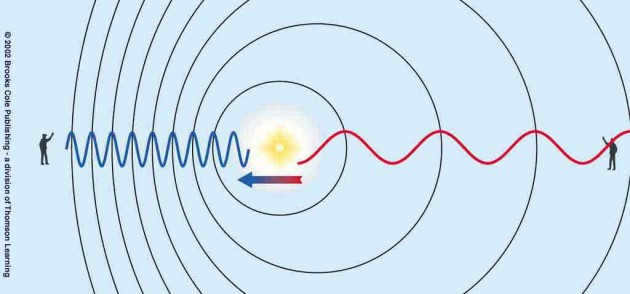
What is the speed of the solar system?
Prior to contemplating the trajectory and velocity of the solar system within the expanse of the galaxy, let us first touch upon our home galaxy, known as the Milky Way.
The Milky Way is a typical example of a medium-sized spiral galaxy with a prominent central lintel. The galaxy disk has a diameter of approximately 100,000 light years (sv. yr.). The Sun is located near the plane of the disk at an average distance of 26,000 +/- 1400 sv yr from the center of the galactic nucleus. It is widely believed that the thickness of the galactic disk around the Sun is around 1000 svg. However, some scientists suggest that this value may reach 2000 – 3000 svg. The estimated number of stars in the Milky Way ranges from 200 to 400 billion. Young stars and star clusters that are no more than a few billion years old are concentrated near the disk plane, forming what is known as the flat component. This region contains many bright and hot stars. The gas in the Galaxy’s disk is also primarily concentrated near its plane.
It’s fascinating how the spiral arms of the galaxy rotate together, maintaining the same angular velocity. At a specific distance from the galaxy’s center, the rotation speed of the arms aligns almost perfectly with the rotation speed of the disk matter. This region, where the angular velocities match, forms a narrow ring or torus with a radius of approximately 250 parsecs. Known as the corotation zone (co-rotation), this ring-shaped area encircles the galaxy’s center.
Scientists have discovered that our solar system is currently situated in a unique area known as the corotation zone. This zone is of great interest to us because it provides ideal conditions for stellar evolution. Due to its placement in this narrow zone, the Sun experiences a state of tranquility and comfort, which some scientists believe fosters the development of biological life forms on planets. The arrangement of star systems within this zone increases the likelihood of life emerging, earning it the nickname “galactic belt of life.” It is anticipated that similar corotation zones exist in other spiral galaxies.
At present, the Sun is positioned on the outskirts of the Orion arm, which lies between the primary spiral arms of Perseus and Sagittarius. Over time, the Sun is gradually progressing towards the Perseus arm. It is projected that the Sun will eventually reach the Perseus arm in the course of several billion years.
What does scientific research indicate regarding the trajectory of the Sun within the Milky Way Galaxy?
Although there is no definitive consensus on this matter, the majority of scientists posit that the Sun follows a weakly elliptical path around the center of our galaxy. This orbit is characterized by a slow and steady traversal of the galactic arms. However, a subset of researchers theorize that the Sun’s orbit may exhibit a more elongated elliptical shape.
It is theorized that during this time period, the Sun is located in the northern region of the galaxy, approximately 20-25 parsecs away from the galactic disk. The Sun’s movement aligns with the galactic disk, creating an angle of about 30 degrees between the ecliptic plane of our solar system and the galactic disk. The diagram below illustrates the typical orientation of the ecliptic plane and the galactic disk.
In addition to its elliptical orbit around the galactic core, the Solar System also undergoes vertical oscillations resembling harmonic waves in relation to the galactic plane. These oscillations cause the Solar System to cross the galactic plane every 30-35 million years, ultimately reaching either the northern or southern hemisphere of the galaxy. Some researchers estimate that the Sun crosses the galactic disk every 20-25 million years.
However, it is highly likely that such a plunging movement could be a regular elongated spiral. In fact, all celestial objects in the universe travel along spirals. And the mind, the creator of all things, also soars along its spiral. We will discuss the spirals of the solar orbit in the second part of our essay, and now we will return to examining the orbital movement of the Sun.
The issue of measuring the speed of the Sun is closely tied to the selection of a reference frame. The solar system is constantly in motion relative to the nearby stars, interstellar gas, and the center of the Milky Way. The movement of the solar system within our galaxy was initially observed by William Herschel.
It has been confirmed that every star, in addition to its overall movement around the center of the galaxy, has its own unique motion, known as peculiar motion. The Sun’s peculiar motion is towards the boundary of the Hercules and Lyra constellations, while its transfer motion is towards the Swan constellation, which is shared with other nearby stars that orbit near the galactic nucleus.
It is estimated that the Sun’s peculiar motion has a speed of approximately 20 km/s and is directed towards a point known as the apex, which is also the direction of motion for other nearby stars. The speed of the transfer or general motion around the center of the galaxy towards the Swan constellation is much faster, estimated to be between 180 and 255 km/s.
Due to the significant disparity in velocity of overall movement, the length of one orbit of the Solar System around the center of the Milky Way (referred to as a galactic year) can range from 180 to 270 million years, depending on various data sources. These values should be noted for future reference.
Based on current scientific data, our solar system is presently situated in the northern hemisphere of the Milky Way and is traveling at an angle of 30 degrees relative to the galactic disk, with an average speed of approximately 220 km/sec. The distance from the galactic disk’s plane is estimated to be around 20-25 parsecs. It has been previously mentioned that the thickness of the galactic disk in the region where the Sun orbits is roughly 1000 sv. yr.
By knowing the thickness of the disk, the elevation of the Sun above the disk, the speed and angle at which the Sun enters the disk, we can determine the amount of time it will take for us to enter the galactic disk and then exit it in the southern hemisphere of the Milky Way.
After performing these simple calculations, we find that it will take approximately 220,000 years for the Solar System to enter the galactic disk, and another 2.7 million years to exit it. Therefore, in around 3 million years, our Sun and Earth will be located in the southern hemisphere of the Milky Way. It should be noted that the chosen value for the thickness of the galactic disk in these calculations can vary greatly, so these results are only estimates.
So, if the current scientific data are accurate, then the inhabitants of the late 6th Root Race and the 7th Race of the Earth will already be residing in the new conditions of the southern hemisphere of the galaxy.
Now, let’s delve into the cosmological records of E.I. Roerich from 1940-1950.
In E.I. Roerich’s essay “Conversations with the Teacher”, specifically the section titled “The Sun” (New Epoch, No. 1/20, 1999), there are brief mentions of the Sun’s galactic orbit. Despite the limited coverage of this topic, the information found in these notes is highly intriguing. When discussing the unique aspects of our Solar System, the Teacher shares the following details.
Our understanding of Astronomy is distinct from that of contemporary astronomers. The exact trajectory of the Sun has not been accurately determined by scientists yet. It will take at least a billion years for the Sun to complete a full orbit along its elliptical path.”
Take note of an extremely important point. In contrast to contemporary astronomy, the Astronomy of the Hidden Knowledge establishes the boundaries of the Solar System not solely based on the orbits of the distant outer planets revolving around the Sun, but also on the solar orbit itself, which encompasses the center of our galaxy. Additionally, it is suggested that the Sun completes one revolution around the galactic center on an elliptical path for a minimum of one billion years. It is worth mentioning that, according to modern scientific data, the Sun completes its revolution around the galactic nucleus in a span of only 180 to 270 million years. In the second part of this essay, we will discuss potential explanations for these significant disparities in the duration of the galactic year. E.I. Roerich proceeds to elaborate on this matter.
“The velocity of the Sun’s journey is significantly faster than the velocity of the Earth as it moves along its elliptical orbit. The Sun’s velocity surpasses that of Jupiter by a considerable margin. However, the Sun’s velocity often goes unnoticed due to the rapid relative velocity of the Zodiac’s movement.”
These statements indicate that there is complete agreement between modern science and the Hidden Knowledge regarding the estimation of the speeds of the Sun’s general motion around the center of the galaxy and its peculiar (own) motion in relation to the nearest stars.
It is worth noting that while the Sun’s general orbital motion has a speed range of 180 – 255 km/sec, the Earth’s average speed along its elliptical orbit is only 30 km/sec, and Jupiter’s is even lower at 13 km/sec. On the other hand, the Sun’s peculiar speed in relation to the bright stars of the zodiacal belt and the nearest stars is only 20 km/sec. As a result, the Sun’s movement in relation to the Zodiac is not particularly noticeable.
The mighty Sun is currently in orbit around the Milky Way and is on a course towards the constellation of Hercules. Along its journey, it will traverse the ring of the Milky Way and forcefully venture beyond it.
From a side view, the center of the Milky Way is clearly depicted. It is evident that the meaning of the last segment of the records closely aligns with the scientific knowledge of our time regarding the Sun’s movement relative to the galactic disk, which is referred to as the “Ring of the Milky Way” in the records. Essentially, it is stated that over time, due to its motion, the Sun will depart from this galactic hemisphere and, after passing through the galactic disk – the Milky Way Ring, will establish itself in the other hemisphere of the galaxy. Naturally, there will then be different stars encompassing the ecliptic, forming a new zodiacal belt.
Furthermore, it is true that the density of galactic matter in the galactic disk varies considerably from the density of matter in the current space we inhabit. Consequently, both the Sun and our entire planetary system will need to acclimate to life in new, potentially harsher cosmic circumstances.
The Sun is expected to pass through the galactic disk, also known as the “ring of the Milky Way,” and rise well above its plane. This observation could be seen as indirect evidence that our solar system follows a curving or spiral path as it orbits around the center of the galaxy, periodically crossing into different galactic hemispheres. However, these records do not definitively prove this fact. It’s possible that the Sun’s trajectory around the galaxy’s center is not wavy but rather a smooth ellipse, albeit one that is tilted at a significant angle to the galactic disk. In that case, there would be two points where the Sun intersects the disk plane: one as it ascends and another as it descends on its orbit.
Thus, it can be observed that the concepts pertaining to the movement of the Sun within the galaxy in modern scientific thought align closely with the standpoint of Esoteric Astronomy. Nevertheless, significant disparities emerge when considering the estimations of the duration of the galactic year and the determination of the spatial boundaries of the Solar System. It is worth noting that scientific sources indicate that the galactic year spans from 180 to 270 million years, whereas Cosmological records suggest that the Sun completes its elliptical orbit in no less than a billion years.
Source: tropojuiskaniy.ru
Previously, the prevailing belief among researchers was that our universe remained stationary, or if it did move, it did so only slightly. However, a team of scientists led by Professor Michael Longo from the University of Michigan (USA) recently made a surprising discovery. They found distinct evidence of our universe’s rotation in space. It appears that the rotation was present right from the moment of the Big Bang, when the Universe came into existence. It is almost as if someone initiated its rotation, much like spinning a yule log. And to this day, it continues to rotate incessantly.
The Sloan Digital Sky Survey (SDSS) was responsible for conducting the research. The scientists involved in the project discovered this phenomenon while cataloging the rotational direction of approximately 16,000 spiral galaxies relative to the north pole of the Milky Way. Initially, the scientists aimed to gather evidence supporting the concept of mirror symmetry in the universe. They hypothesized that the number of galaxies rotating clockwise and those rotating counterclockwise would be equal. However, their findings revealed that counterclockwise rotation dominates among the spiral galaxies located towards the north pole of the Milky Way, indicating a rightward orientation. This pattern persists even at distances exceeding 600 million light-years.
– The violation of symmetry is minimal, amounting to only approximately seven percent, but the likelihood of this being a random cosmic accident is estimated to be around one in a million, stated Professor Longo. – Our findings are highly significant as they appear to contradict the widely accepted belief that on a sufficiently large scale, the universe is isotropic, meaning it lacks a distinct direction.
According to experts, a symmetric and isotropic Universe would have originated from a spherically symmetric explosion, taking the shape of a basketball. However, if the Universe had rotated around its axis in a particular direction during its birth, the galaxies would have retained this rotational alignment. Given that galaxies rotate in various directions, it suggests that the Big Bang had a different orientation. Nonetheless, it remains probable that the Universe is still undergoing rotation.
Indeed, the concept of symmetry breaking and isotropy has been the subject of speculation by astrophysicists in the past. Their conjectures were formulated based on their observations of other extraordinary phenomena. These include the presence of cosmic strings – extremely long defects in space-time with no thickness, which are theorized to have originated shortly after the Big Bang. The existence of “bruises” on the fabric of the universe, which are believed to be remnants of its past interactions with other universes. Additionally, the motion of the “Dark Stream” – an immense flow of galactic clusters that is propelled at a tremendous velocity in a single direction.
The Sun, which is part of the Milky Way galaxy, is situated 8 kiloparsecs from the galactic center and 25 parsecs from the galactic plane. In our specific region of the galaxy, the stellar density is approximately 0.12 stars per cubic parsec. The position of the Solar System is not static, as it is constantly in motion relative to neighboring stars, interstellar gas, and ultimately around the center of the Milky Way. This movement of the Solar System within the galaxy was initially documented by William Herschel.
Motion in relation to the neighboring stars
The speed at which the Sun is moving towards the boundary between the constellations Hercules and Lyra is 4 arc seconds per annum, equivalent to 20 kilometers per second. The vector of velocity is aimed towards a specific point known as the apex, which is the same direction that the nearby stars are also moving towards. The paths of motion for stars, including the Sun, intersect at the opposing point of the apex, referred to as the antiapex.
Motion with respect to the visible celestial bodies
The Sun’s motion relative to the prominent stars that are visible without the need for a telescope is measured independently. This serves as an indication of the typical movement of the Sun. The rate at which it moves is 3 astronomical units per year or 15 kilometers per second.
Movement in relation to the vast expanse of interstellar space
In comparison to the expansive realm of interstellar space, the Solar System moves at a faster pace, with a speed of 22-25 kilometers per second. Additionally, due to the influence of the “interstellar wind” emanating from the southern region of the Galaxy, the apex gradually shifts towards the constellation Serpentine. The estimated displacement amounts to approximately 50 units.
Movement in the vicinity of the Milky Way’s center
The center of our Galaxy, known as the apex, is concealed by dense interstellar dust, making it difficult to accurately measure the exact speed of the solar system’s motion. However, it is estimated that the solar system is currently moving towards the constellation of Swan at a speed of approximately 40 astronomical units per year, which is equivalent to 200 kilometers per second. A full revolution around the center of the Milky Way takes approximately 220 million years.
Additionally, the apex undergoes a gradual shift of 1.5 degrees every million years, completing a full circle in 250 million years, or what is referred to as a “galactic year”.
Exploring the outer reaches of the Milky Way
Similar to the rest of the celestial bodies in our solar system, the Earth revolves around the Sun. In order to maintain its orbit, it maintains a velocity of 30 km/s. Venus and Mercury, being closer to the Sun, have a higher velocity; Mars, on the other hand, moves much slower as its orbit is positioned behind that of the Earth.
However, even the Sun itself is not stationary. Our vast and colossal Milky Way galaxy is also in motion! All the stars, planets, gas clouds, dust particles, black holes, and dark matter are all in constant motion with respect to a shared center of mass.
Scientists believe that the Sun is located approximately 25,000 light years away from the center of our galaxy and follows an elliptical path, completing a full revolution every 220-250 million years. This means that the Sun travels at a speed of about 200-220 km/s, which is hundreds of times faster than the Earth’s rotation speed and dozens of times faster than its orbit around the Sun. This is how our solar system moves.
But is the galaxy itself stationary? The answer is no. Massive cosmic objects have significant mass, resulting in strong gravitational fields. Over time (and we have had plenty of it – around 13.8 billion years), objects in the universe start moving towards the areas of strongest gravity. This is why the Universe is not uniform, but instead consists of galaxies and groups of galaxies.
What is the significance of this for us?
This has implications for us as it indicates that the Milky Way is experiencing gravitational attraction from other nearby galaxies and galaxy groups. It suggests that the presence of massive objects is driving this phenomenon. Additionally, it implies that not only our galaxy, but also the surrounding galaxies, are being influenced by these gravitational forces. While we are making progress in understanding the dynamics of outer space, there are still unanswered questions, such as:
- What were the initial conditions that gave rise to the universe?
- How do different masses within the galaxy move and evolve over time?
- What processes led to the formation of the Milky Way and the surrounding galaxies and clusters?
- And how are these processes unfolding presently?
Nevertheless, there is a method to help us unravel these mysteries.
The cosmos is teeming with leftover radiation that has been conserved since the inception of the Big Bang, boasting a temperature of 2.725 K. Although there are minuscule fluctuations in certain regions, approximately 100 µK, the overarching background temperature remains steadfast.
This phenomenon can be attributed to the fact that the Universe originated from the Big Bang event 13.8 billion years ago and continues to expand and undergo cooling.
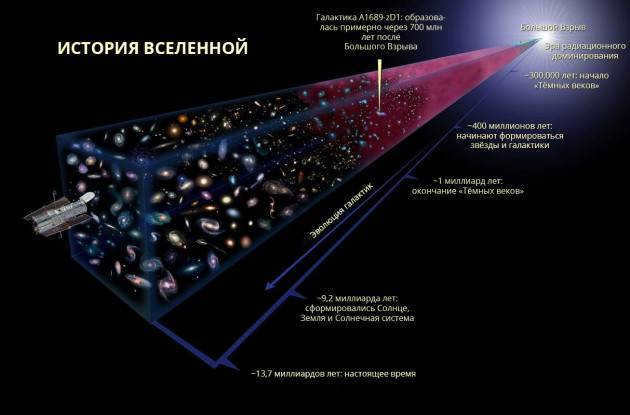
After the Big Bang, approximately 380,000 years later, the Universe reached a temperature that allowed hydrogen atoms to form. Prior to this, photons constantly interacted with the surrounding plasma, colliding and exchanging energy. As the Universe cooled down, the number of charged particles decreased and more space emerged between them. This allowed photons to freely move through space. Relict radiation refers to the photons that were emitted by the plasma towards the future location of Earth but managed to avoid scattering due to the ongoing process of recombination. These photons travel through the expanding Universe and eventually reach Earth.

You have the opportunity to visually observe this radiation. The disruption that occurs on an unoccupied television channel when utilizing a basic antenna resembling the ears of a hare is attributed to relic radiation to the extent of 1%.
Nevertheless, the temperature of the residual background is not uniform in every direction. As indicated by the findings of the Planck mission, there is a slight variation in temperature between opposite hemispheres of the celestial sphere: it is marginally higher in certain areas of the sky to the south of the ecliptic, measuring approximately 2.728 K, while it is lower in the other half, measuring approximately 2.722 K.
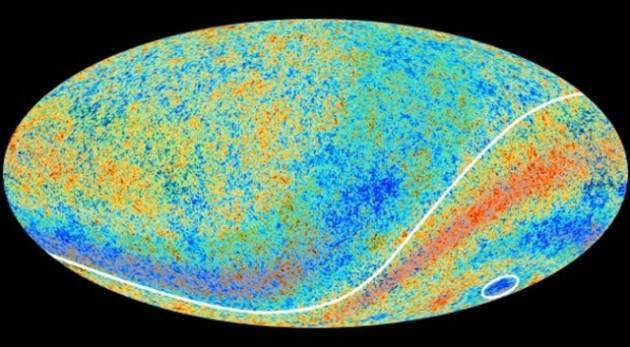
This disparity is nearly 100 times greater than the other detected fluctuations in the background temperature of the relic radiation, and it is deceptive. Why does this occurrence transpire? The response is apparent – this dissimilarity arises not from fluctuations in the relic radiation, but rather from the presence of motion!

When an observer moves towards a light source or the light source moves towards the observer, the spectral lines in the source’s spectrum shift towards shorter wavelengths, resulting in a violet shift. Conversely, when an observer moves away from a light source or the light source moves away from the observer, the spectral lines shift towards longer wavelengths, resulting in a red shift.
Relict radiation cannot have varying levels of energy, indicating that our movement through space is constant. By utilizing the Doppler effect, scientists have determined that our solar system is moving at a speed of 368 ± 2 km/s relative to relict radiation. Furthermore, a local cluster of galaxies, including the Milky Way, the Andromeda galaxy, and the Triangle galaxy, are moving at a speed of 627 ± 22 km/s relative to relict radiation. These velocities, known as peculiar velocities, reach several hundred km/s. Additionally, there are also cosmological velocities caused by the expansion of the Universe, which can be calculated using Hubble’s law.
Thanks to the residual radiation from the Big Bang, we are able to observe the constant movement and change within the Universe. Our galaxy, the Milky Way, is just one component of this ongoing process.
Gallactic Movements
The Anglo-German astronomer William Herschel made an astounding discovery regarding the movements of the solar system within the galaxy. He deduced that the Sun’s trajectory was directed towards the star Maasim, also known as Lambda in Hercules, with a velocity of 20 km/s. Remarkably, modern calculations deviate only slightly, by a mere ten degrees, from Herschel’s original findings. This peculiar motion is referred to as the general motion. Additionally, there exists a portable movement of the solar system within the galaxy, which astronomers have dubbed. The Sun, along with its neighboring stars that orbit around the galactic center, is inclined towards the constellation of Swan, with a velocity ranging between 200 to 250 km/s.
Stars, dust, and gas exhibit different rotational speeds depending on their positions and distances from the center. Spiral clusters typically have both the celestial bodies nearer to the core and those farther away rotating at approximately the same orbital velocity. However, within the Milky Way, objects with orbits closer to the center rotate at a slower pace compared to those farther out. The Sun follows an almost perfectly circular orbit, traveling at a speed of 828,000 kilometers per hour as reported in 2009. It takes approximately 230 million years for a complete revolution around the disk’s center, equivalent to a galactic year.
In addition to its orbital rotation, the Milky Way also experiences vertical oscillations within its plane. The intersection of this plane occurs approximately every 30 million years, resulting in the Sun’s location shifting between the northern and southern parts of the galaxy. Currently, the Sun is situated in the northern hemisphere, about 20-25 parsecs away from the disk’s plane. The Local Interstellar Cloud (LIC) is currently in transit, and our solar system entered it around 50-150 thousand years ago. Scientists predict that we will exit the LIC in approximately 20 thousand years.
Movement in the vastness of the universe
The solar system is in perpetual motion and constantly moving in relation to other celestial bodies, interstellar gas, and various objects. While some objects are moving away from us, others are approaching. It has been determined that there is an approaching movement towards the Andromeda galaxy at a speed of 120-150 km/s, and on a larger scale, there is an approach towards the Virgo Supercluster at a speed of 300-400 km/s.
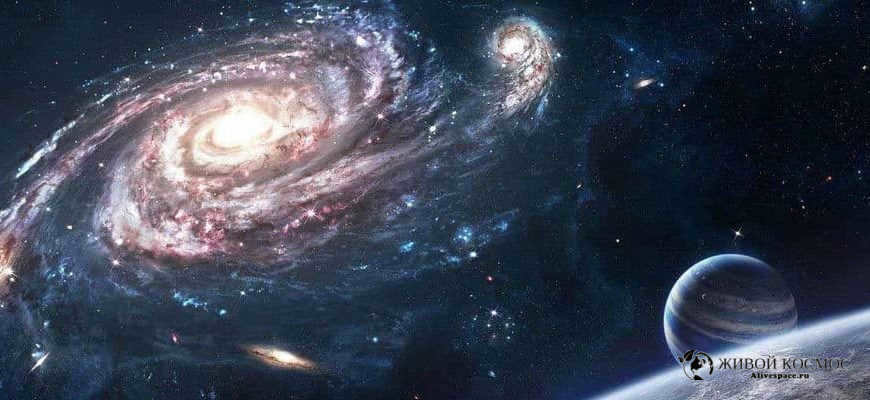
While luxuriously ensconced in your preferred seat, occasionally perusing peculiar articles featured within the confines of our endeavor, it may appear to you that the realm in which you reside remains static. Furthermore, it may seem that you, indeed, are not currently hurtling through the vast expanse of the cosmos. This perception arises from the fact that the human brain gauges its velocity in relation to proximate surfaces and objects. Alas, the veracity of this perception is quite disparate from reality. In actuality, our velocity fluctuates contingent upon the reference point we select….
First of all, let’s realize that we are situated on the Earth’s surface, which spins around its axis, causing all of us to trace immense circles every 24 hours. In addition, the Earth orbits around the Sun, and the Sun itself revolves around the center of the Milky Way. The Milky Way, in turn, is not stationary either. It moves as a component of the Local Group of galaxies through space towards an enormous gravitational object known as the Great Attractor, according to scientists.
All these movements result in us traversing the Universe at an incredibly fast pace!
Everything is relative
Let’s reiterate that all velocities are relative. In other words, we can only determine how one object is moving in relation to another. We will never be able to ascertain the absolute velocity of an object. This is because we would need information about a completely stationary point in the Universe, which unfortunately does not exist.
Accepting this fact, the answer to the question posed in the title of this article is quite simple: we do not know our velocity as we move through the universe. Our absolute speed remains unknown. However, we can still calculate some relative velocities.
In order to embark on a thrilling race through the universe, we must select a starting point. I propose an excellent choice: the most comfortable chair in your home.
So, get ready. Because the adventure is about to begin!
First, let’s have a look around. Comparing ourselves and our chair to the walls and other objects around us, we are not moving. Therefore, our initial velocity is zero!
Velocity in relation to the Earth’s axis
We are located on the Earth’s surface, which rotates around its axis. If our house were situated at the pole, our movement would consist of slowly rotating. This rotation would take 24 hours. However, the farther our home is from the poles, the farther we will be from the Earth’s axis of rotation. Consequently, we would describe a larger circumference around it.
Simply put, the individuals who move at a quicker pace are the ones who cover the largest distance within a 24-hour span. In other words, those who are located in close proximity to the equator. Consequently, if you currently find yourself in Quito, the capital of Ecuador, I urge you to brace yourself! This city is currently hurtling through space at an astounding velocity of 1,670 kilometers per hour. That’s even faster than the speed of sound!
Speed in relation to the sun
The Sun is orbited by the Earth, following a circular path with a radius of 150 million kilometers. The velocity along this path is 107,208 kilometers per hour, which is equivalent to 87 times the speed of sound. When we combine this velocity with the Earth’s rotational motion, we obtain our speed relative to the Sun.
The velocity of the Sun’s motion around the center of the Milky Way.
The Sun is among a multitude of stars that revolve around the central region of our Milky Way galaxy. The sheer vastness of the Milky Way makes it difficult to comprehend using conventional units of measurement.
To gain some perspective, let’s consider that the Sun’s orbital radius around the galactic center, in terms of kilometers, amounts to 250,000,000,000,000,000,000,000,000,000 kilometers. This value is so immense that astronomers opted not to tally all those zeros, and instead devised a specialized unit of measurement – the light year. It represents the distance traveled by light in one year. Yet even employing this unit, we arrive at an astronomical figure – the Sun’s distance to the center of the Milky Way is 25,000 light years!
Therefore, the Sun is in constant motion around the galactic center, completing a massive orbit at a speed of 792,000 kilometers per hour or 220 kilometers per second. This incredible velocity would allow you to orbit the Earth in just three minutes.
Velocity within the Local Group
Within the vast expanse of the universe, the Milky Way is a member of a collection of galaxies referred to as the Local Group. This assemblage consists of a total of 30 galaxies, with two galaxies, our very own Milky Way and the Andromeda galaxy, dominating in terms of size. Remarkably, these galaxies are currently moving towards each other at an astonishing speed of 468,000 km/h (130 km/s). If this trend persists, a cosmic collision between these galactic giants will occur in the far off future, approximately 5 billion years from now.
The local cluster is a component of the larger entity known as the Virgo Cluster. However, initially, it posed a significant challenge to determine its velocity of motion. In the past, the Universe was believed to be uniform, making it impossible to ascertain the direction and speed at which our galaxy group was moving, regardless of where we looked. Fortunately, advanced tools have now become accessible, enabling scientists to measure the relative velocities of an extensive array of galaxies. As a result, they made a surprising revelation that the Universe is far from uniform!
It transpired that a minimum of several million galaxies in close proximity to the Milky Way were moving collectively in a specific direction within space!
In 1987, a team of seven astronomers conducted a study on the synchronized movement of millions of galaxies in our vicinity. Their findings revealed that all these galaxies, including our own Milky Way, are hurtling through space at an astonishing speed of 600 kilometers per second, which is equivalent to a mind-boggling 2,160,000 kilometers per hour!
Evidently, the cause behind this extraordinary velocity is the gravitational pull exerted by a vast expanse of space aptly named the “Great Attractor”.
To summarize, it is quite challenging to calculate the exact value of our overall speed as we traverse the vastness of the Universe. This is due to the fact that the velocities we have discussed today point in different directions, resulting in some velocities being added while others are subtracted. The specific speed at any given moment depends on our particular trajectory.
I don’t know about you, but the thought of such incredible speeds makes me feel incredibly dizzy.
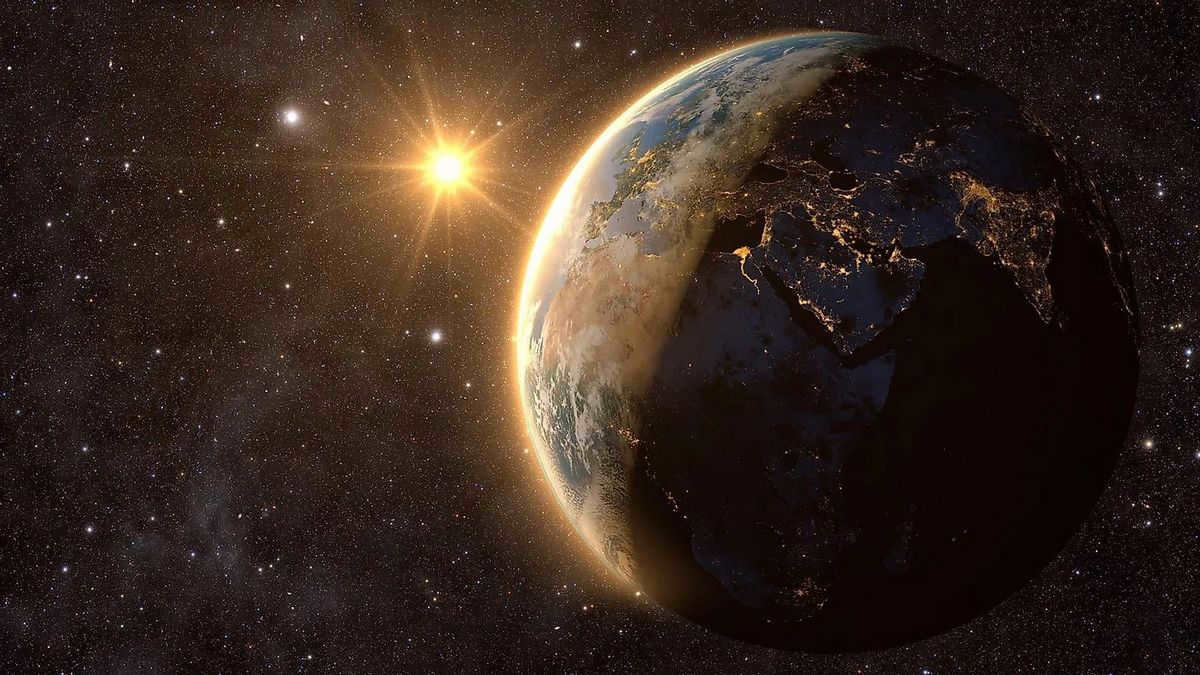
From our everyday perspective, the Earth appears to be stationary. Just a few centuries ago, the notion of the Earth in motion was considered ludicrous, but it is now widely accepted.
Despite our inability to perceive it, our planet is currently rotating on its axis and orbiting the Sun. Thanks to the Earth’s gravitational pull, we remain firmly grounded and oblivious to its movement. However, have you ever wondered how fast the Earth is actually moving?
The Earth’s Rotation Speed
The Earth’s rotation has a significant impact on everyone living on it. It is responsible for the cycle of day and night, which repeats every 24 hours as the Earth turns on its axis. The duration of a full day, 24 hours, is the time it takes for the Earth to complete one full rotation.
Interestingly, by knowing the Earth’s rotation time and the equatorial circumference of the Earth, it is possible to easily calculate the speed at which the Earth rotates.
All you need to do is divide the circumference by the duration of the day. The Earth’s equatorial circumference is approximately 40,070 kilometers, which can be divided by 24 hours to determine the rotational speed.
By performing this action, we obtain a rotational velocity of 1,670 kilometers per hour (460 meters per second). Since this value is computed based on the length of the equatorial circumference, the rotational velocity of the Earth varies across different regions of the planet. As one moves towards the northern or southern hemispheres from the equator, the Earth’s rotational speed diminishes accordingly.
Aside from its rotation, the Earth also orbits the Sun. The calculation of orbital velocity is similar to that of rotational velocity.
To determine orbital velocity, you must be aware of the time it takes for the Earth to complete one revolution around the Sun, as well as the total distance it covers during this orbit. Once you have these values, you can simply divide the distance by the time to obtain the speed.
It takes the Earth approximately 365 days, or one year, to complete an orbit around the Sun. Throughout this year-long journey, the Earth covers a distance of about 940 million kilometers. By dividing this distance by the number of days in a year, we can determine that the Earth travels at a speed of roughly 2.6 million kilometers per day. This means that every hour, our planet moves approximately 107,226 kilometers. On average, this translates to a speed of just under 30 kilometers per second. It’s important to note that the actual speed of the Earth varies throughout the year, as it moves between its closest point to the Sun (perihelion) and its farthest point (aphelion).
The velocity of the Solar System
Although we are all aware that the Earth rotates on its axis and orbits around the Sun, these are just two types of motion that the Earth undergoes.
In addition to these two forms of motion, the Earth also traverses through our Milky Way Galaxy along with the Sun. Similar to all planets, the Sun has a path. Concerning the Sun, it revolves around the center of the Milky Way and drags the entire solar system with it.
Currently, the Solar System is hurtling through the Milky Way at a speed of 720,000 kilometers per hour. While this may appear incredibly fast, it still takes the sun approximately 230 million years to complete one revolution around the galaxy.
Traveling through the universe at warp speed
Each and every galaxy in the vast expanse of the universe is in constant motion, and this includes our very own galaxy, the Milky Way. At this very moment, our magnificent galaxy is hurtling through space at an astounding velocity of 112 kilometers per second towards its neighboring galaxy, Andromeda.
In the distant future, within the span of four to five billion years, an extraordinary event will take place – the Milky Way and Andromeda will engage in a cosmic dance, colliding with tremendous force, and ultimately merging together to form a singular, awe-inspiring galaxy.
All large objects in our nearby universe exert a gravitational pull on us, while regions that are less dense – those that have lost the matter they once had to denser regions surrounding them – exert a much weaker force on us, which is actually repulsive in nature, and is significantly lower than the average cosmic force.
The majority of the gravitational force in our local group of galaxies is caused by the Virgo supercluster, which is drawing us towards it at a speed of approximately 300 km/s relative to our overall cosmic motion. However, on the opposite side of the sky, opposite the center of the Virgo cluster, there is a much less densely populated area of space.
While the densely populated regions are referred to as clusters, the less dense regions are referred to as voids, and the void we are in is actually pushing us away from it, also at a speed of around 300 km/s.
With a dense cluster of galaxies on one side and an empty void on the other, there is a combined force of attraction and repulsion that results in a net motion of approximately ~600 km/s for our local group of galaxies.
The overall velocity of movement in the Universe
Overall, our total motion through space is approximately 368 km/s in a specific direction: towards the Leo constellation. Throughout the year, this velocity can vary by about 30 km/s, primarily due to the changing movement of the Earth around the Sun.
This conclusion is supported by measurements of the cosmic microwave background radiation, which appears hotter in the direction we are moving (towards Leo) and cooler in the opposite direction (away from the Aquarius constellation).

